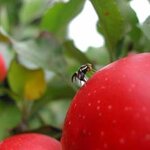Evolution

This statement about natural selection is the last sentence of Adaptation and Natural Selection, George Williams' masterpiece about evolution. George Williams is one of the unsung heroes of 20th century science. An evolutionary biologist I know (who shall remain anonymous to spare him/her public shaming) claimed not to know who was George Williams. I was/still am aghast. This anonymous evolutionary biologist is the inspiration for this post, indeed for my series of citation classics (see also here).
Williams is a professor emeritus at SUNY: Stony Brook, author of numerous influential books,…

There is no question that humans are unique among living things in possessing a rich communications vehicle like language. However, by itself, this is insufficient to explain why such a thing should exist, so it might be useful to examine what is it that makes humans unique among animals?
Often we hear arguments about consciousness, or intelligence, or some other element, but to my mind these are too vague to be of much use, since we often see similar capabilities among animals that do not possess a language.
In the previous two posts, I have argued that the role of a belief system, or…

In this installment I would like to extend the concepts of belief systems into other areas that we are all familiar with but haven’t necessarily explored.
The data organization capability of the brain which defines the worldview or belief system of the individual isn’t just haphazardly developed, but is guided by the teaching and beliefs of parents and society. It is no coincidence that beliefs formed in childhood are ultimately the hardest to modify.
Belief systems are so important that I suspect there’s more force in the Santa Claus and Easter Bunny stories than many people give credit for…

Animals have an astonishing ability to develop reliably, in spite of variable conditions during embryogenesis. New research published this week addresses how living things can develop into precise, adult forms when there is so much variation present during their development stages. A team led by John Reinitz at Stony Brook University, and funded by the National Institutes of Health, shows how fruit fly embryos can "forget" initial incorrect versions of their body plan and develop into recognizable adult flies.
Canalization, a principle of developmental biology described more than 60…

This is a three part series that will explore the nature of belief systems, or worldviews and offer some perspectives on how they are formed and function.
Belief systems are fundamental to human existence and there are a few ideas worth exploring to see if anything can be determined about their origins. Without getting into brain physiology or psychology, there are a few conclusions we can draw from general observation.
The brain is our information processing center, so it is capable of accepting data input and analyzing it. However, let’s break the functions down a little more precisely.…

A team of researchers has reported the ongoing emergence of a new species of fruit fly and the sequential development of a new species of wasp. Jeff Feder, a University of Notre Dame biologist, and his colleagues say the introduction of apples to America almost 400 years ago ultimately may have changed the behavior of a fruit fly, leading to its modification and the subsequent modification of a parasitic wasp that feeds on it.
The result is a chain reaction of biodiversity where the modification of one species triggers the sequential modification of a second, dependent species. The…

The Wallace Line is called such because when Alfred Russel Wallace made his way to the East Indies to tackle the secrets of biology, he found there was a 'line' in the Malay Archipelago that divides Indonesia into two parts and west of it the species were Asian while to the east they were more Australian.
Since the distance is short in places, Bali and Lombok are only about 35 km apart, it was a prime example of species distinction and biogeography and he wrote on it in The Malay Archipelago.
The abrupt switch in the kinds of mammals found along the Malay Peninsula, from mainland species to…

Show Me The Science Month Day 22
How do genes work together to build body traits? This is one of the hottest questions in genetics today, and the answer holds implications not only for our understanding of evolution, but also health, agriculture, and wildlife conservation. A recent paper in Science (by Scientific Blogging's own Redneck Geneticist) takes a look at how genetic variants work together to generate the physical diversity that we see in living organisms.
In high school biology class, most of us learned very simple genetics, using examples of Mendel's round or wrinkled peas, and red…

Below is a detailed response to my latest post, which Ken graciously sent me for publication here. After that, you will find a few additional notes from yours truly.
Dear Massimo,
Thanks, of course, for the very kind comments about my presentation at Brown. At your invitation, I’m writing a few comments to clarify and correct what I think are some mistaken impressions and also to point out a few areas of genuine disagreement. You wrote:
"Ken … quickly summarized the reasons why intelligent design is not science, why it is no threat to the theory of evolution, and why therefore the latter but…

What use is half a wing?
When Charles Darwin unleashed his revolutionary theory of evolution in the mid-1800s, one of the first questions doubters nailed him with went something like ; you have the four limbs of a reptile and then a beautiful flying bird. What are the intermediary steps? Darwin, what use is half a wing?
There wasn’t much the esteemed naturalist could say with the data he had available and, during the next 150 years, scientists were largely divided into two theoretical camps regarding the evolution of flight.
The arborealists, who are generally ornithologists, think bird…